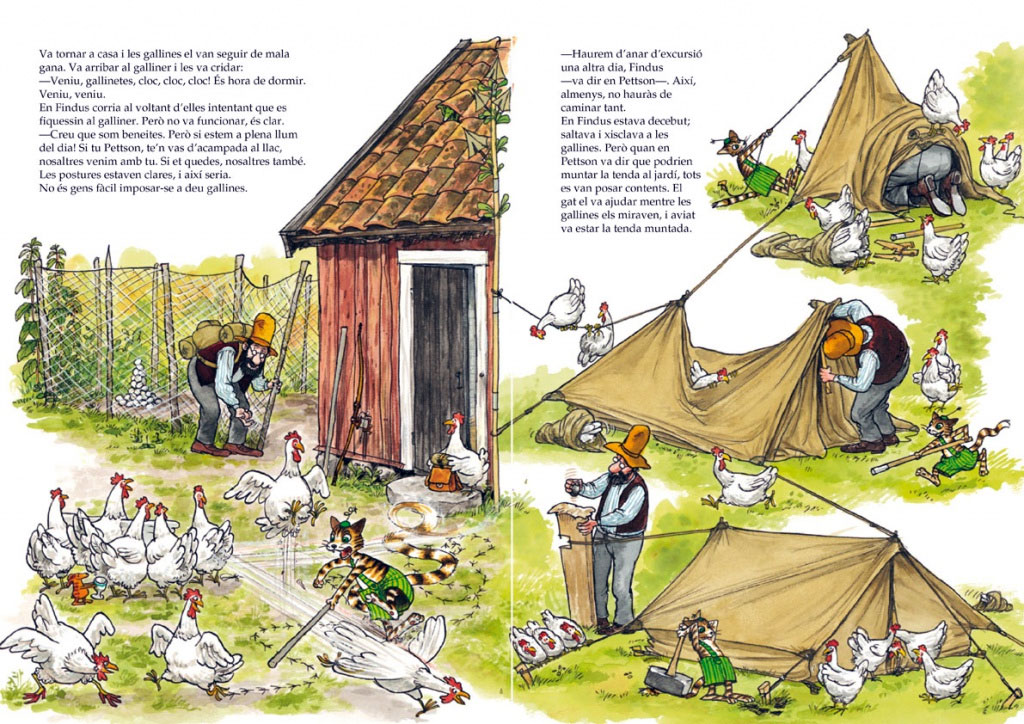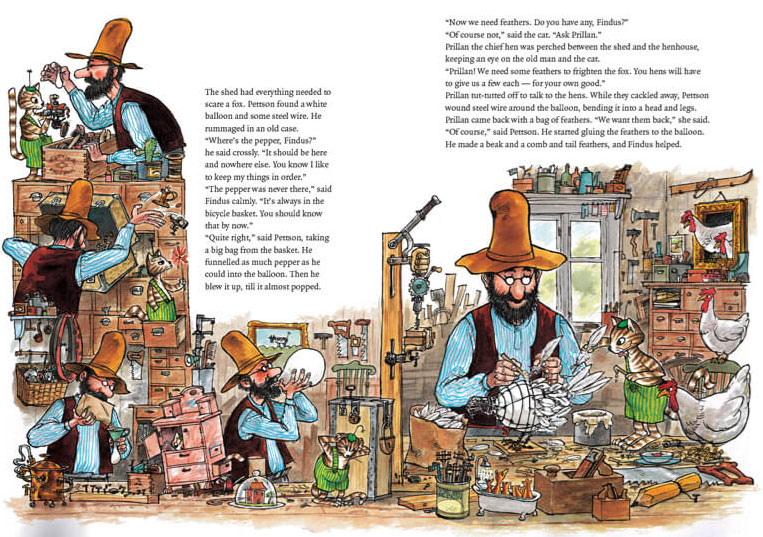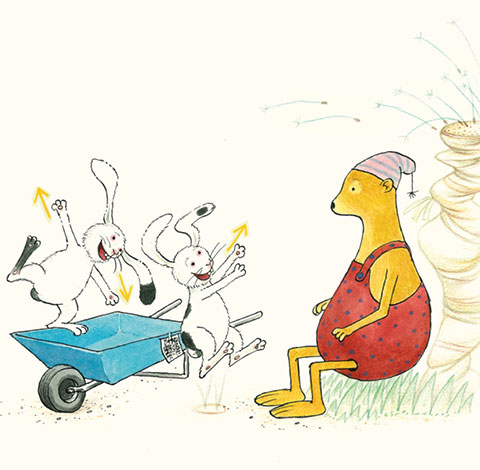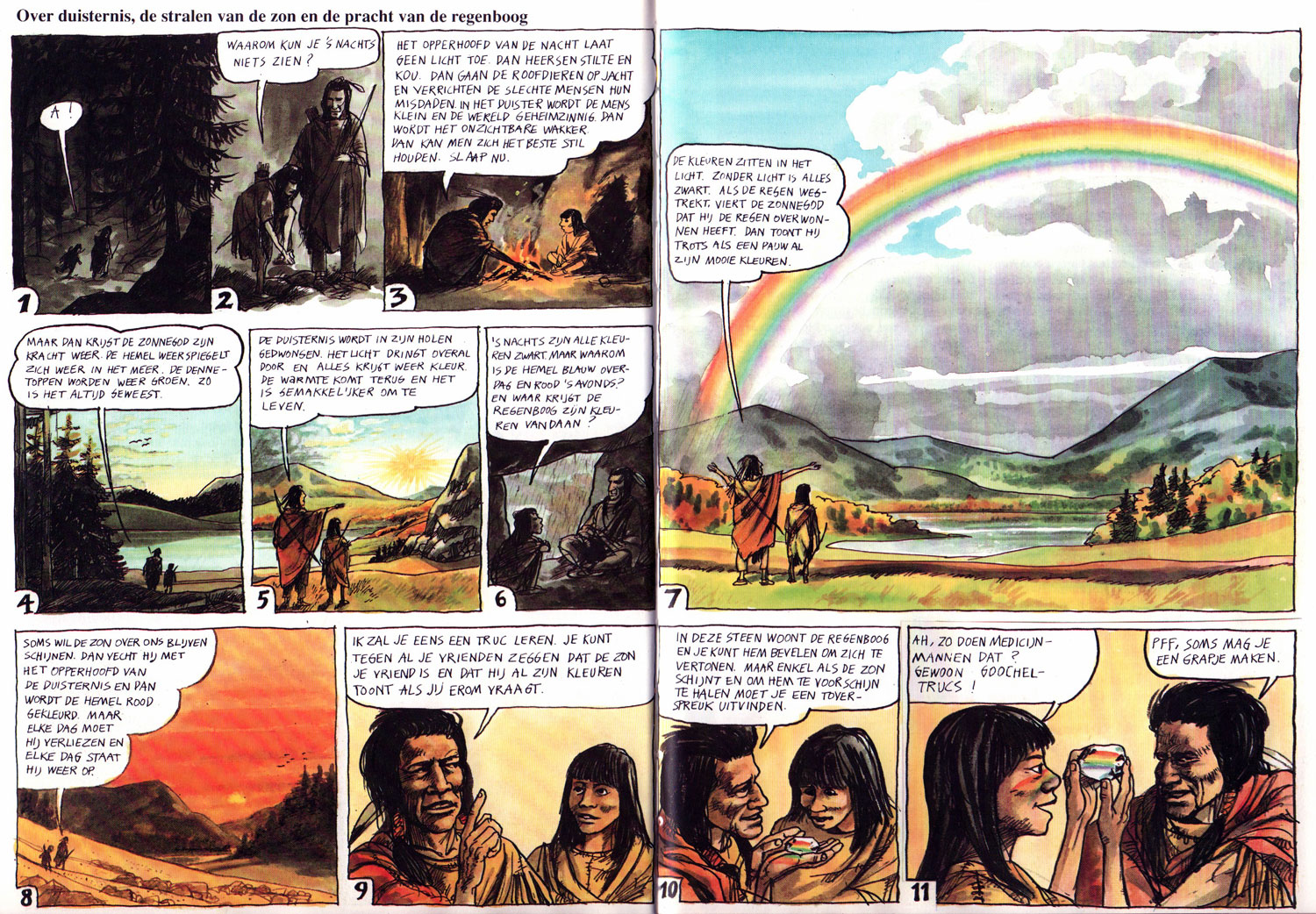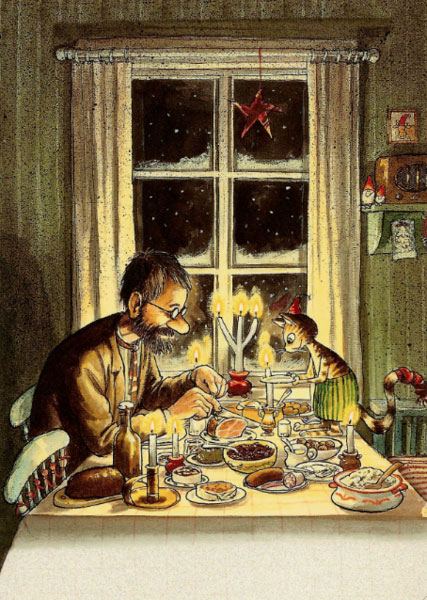Sven Nordqvist is a Swedish children's book writer and illustrator, most famous for his stories about the old farmer Pettson and his suspender-wearing cat Findus (1984). His books have been translated into many languages and adapted in various media, including comics. Another well-known series with his illustrations is 'Mamma Mu och Kråkan' ('Mama Moo and the Crow'), written by Jujja and Tomas Wieslander. Nordqvist works with pen, ink and water paint in a characteristic loose style. He has also made comics, printed in the children's science book 'Magiska linser och hemliga skåp' ('Magical Lenses and Secret Chambers', 1989), written by Pelle Eckerman.
Early life and career
Sven Otto Rickard Nordqvist was born in 1946 in Helsingborg, a town in the southwest of Sweden. His father was a high school teacher, and his mother worked as a cartographer and medical secretary. His parents divorced when he was two, whereupon Sven and his older brother moved with their mother to Halmstad, where they lived with their maternal grandparents. Spending much of his childhood in the countryside, Nordqvist at one point wanted to become a farmer, but eventually was more interested in arts. Among his influences were Mad Magazine's Mort Drucker, the Danish cartoonist Storm P, the 19th-century French caricaturist Gustave Doré, the British illustrators Ronald Searle and Ralph Steadman, as well as the Swedish entertainer Povel Ramel. Rejected from art school, he took a Famous Artists drawing correspondence course. Starting at age fifteen, it took him three years to complete, but Nordqvist later claimed he learned more through this method than he would ever have at Art Academy. At the same time, the artist studied Architecture at the Technical University of Lund. After graduation, Nordqvist worked as an architect for a year, after which he lectured on this artform at his former university.
Nordqvist became an illustrator for an advertising company in Halmstad, where he illustrated postcards, greeting cards, school and picture books, and also learned to work in photography. Between 1975 and 1985, he was active as a graphic designer. He was also a member of Amnesty International and made drawings for this organization.
Children's books
In 1982, the publishing company Bokförlaget Opal organized a picture book contest. Nordqvist participated, using a story he wrote himself. The end result, 'Agaton Öman en Alfabeter' ('Agaton Öman and the Alphabet') was a playful work on how to learn the ABC. The jury promptly declared it the winner. Its 1983 publication launched Nordqvist's career as children's book author. Between 1991 and 2011, he became a member of the Swedish Children's Book Academy.
'Pettson Goes Camping' (from a Spanish edition).
Pettson and Findus
In 1984, Sven Nordqvist created his best-known children's book series 'Pettson och Findus', which took off with the first title 'Pannkakstårtan' ('Pancake cake'). The main characters are Pettson, an old, bearded, bespectacled farmer with a straw hat. He lives together with his hyperactive striped cat Findus, who was named after a Swedish frozen food brand. Nordqvist originally wanted to write a story about elderly people, an age group he's very fond of. Just like Pettson, he also enjoys carpenting. Eventually, Nordqvist settled on a single old man with a talking cat as his sidekick. Findus the cat is silly, impatient, often gets himself into trouble, which appeals to children. Pettson acts like a father figure. Nordqvist said that all children crave freedom, which Findus represents, while Pettson offers what children need: stability and a safe environment. Another funny pet on the farm is Prillan the chicken. Pettson has a friendly rivalry with the neighboring farmer Gustavsson and his dog. The two are often at odds, because Gustavvson is in favor of game hunting, while Pettson likes animals. Pettson gets along much better with Gustavsson's wife Elsa and their son Axel. Perhaps the oddest characters in the series are the Mucklor, little creatures who play pranks on Pettson by hiding his socks or shelving books in the wrong place. However, they can only be seen by Findus.
The 'Pettson and Findus' stories feature a lot of puns. Another delight are Nordqvist's busy, detailed and atmospheric drawings. He often draws idyllic scenes of nature and countryside life, inspired by his own childhood memories. Pettson and Findus go out camping, fishing or strolling in the woods. Their house has a charming, nostalgic look. Pettson's red-painted home is worn out. His toolshed, kitchen and garden are cluttered with dozens of individual objects, leaving readers to spot dozens of funny and intriguing details. When Pettson works, Findus is usually playing around, while the Mucklor are setting up pranks. To indicate the passing of time, Nordqvist often draws them several times within the same illustration, making a sequence comparable to comic art. Interviewed by Editorial Flamboyant in November 2010, the illustrator explained: "Maybe my characters look like comic book characters because they are sketched, contrary to other artists, who follow more traditional artistic drawing styles. Sometimes I use kinetic lines and vignettes to show rapid movements. I use it because it works, although it contributes to the idea that my illustrations cannot be considered art. The fact that Pettson or Findus sometimes appear several times within the same illustration is perhaps reminiscent of film. To me it's a way to expand a scene in space and time without using more than one page. Or to give an impression of fast actions."
'Findus and the Fox'.
The series is very popular in Nordqvist's home country, as well as in Germany. Between 1984 and 2015, fourteen titles were published. The books have been translated into more than 35 languages, including Danish ('Peddersen og Findus'), Finnish ('Pesonen ja Viiru'), Dutch ('Pettson en Findus'), German ('Petterson und Findus'), French ('Pettson et Picpus'), English ('Pettson and Findus', also as 'Festus and Mercury'), Polish and Russian. The adventures of the farmer and his cat were adapted into theatrical plays, audio books, a board game, video games and annual Christmas calendars. In 1993, the 'Pettson and Findus' animated Christmas TV special 'Tomtemaskinen' ('The Santa Machine') was made, and is broadcast on Swedish television each December in 24 episodes leading up to Christmas Eve. Between 1999 and 2018, the Swedish animation studio Happy Live produced seven animated feature films. The humorous musical group Bröderna Slut recorded several children's songs about Pettson and Findus. In 2000, Pettson's farm was built in real life in the Junibacken open-air children's museum near the former Julita monastery in Södermanland, Sweden. Sven Nordqvist himself was responsible for some of the furniture and interior designs. A similar real-life Pettson house can be found in the Gröna Lund Pettson's farm in Djurgården. In the 2000s, 'Pettson & Findus' was adapted into a comic strip by Sören Axén, printed in a magazine of the same name, published by Egmont.
'Nasse'.
Children's book author
Between 1988 and 1991, Nordqvist wrote and drew three children's books about Nasse ('Porker' or 'Bjorn Bear' in English), a bear in a striped hat and polka-dotted trousers. Happy Life adapted the series into an animated TV series. Nordqvist's most awarded one-shot children's book is 'Var är min syster?' ('Where Is My Sister?', 2007), about a little mouse and his wise uncle who use a hot air balloon to search for the mouse's missing sister. In order to find her, he must get "into her head" and imagine where she would like to go during her travels. Nordqvist worked more than 25 years on the initial idea.
Mamma Mu
Since 1991, Sven Nordqvist additionally is known as the illustrator of Jujja and Tomas Wieslander's children's book series 'Mama Mu och Kråkan', about a cow and a crow. The characters originated in a children's radio show, 'Kråkan och Mamma Mu' (1990), broadcast on Sveriges Radio P3. Jujja Wieslander voiced Mamma Mu, while Anders Ågren voiced Kråkan. The animal duo caught on and was adapted into various commercial products, including pillows, video games, a 2008 animated film, a 2009-2010 animated TV series and audio plays. Since 2015, a 'Mamma Mu och Kråkan' comic book series, written by Jujja Wieslander with the illustrator Micaela Favilla and colorist Elin Fahlstedt, has been published by Rabén & Sjögren.
Illustrator of children's fiction
Apart from his own books, Sven Nordqvist livened up the pages of Casper Verner-Carlson's 'Bubblan under isen' ("The Bubble Under the Ice", 1988), which was translated into Danish and Dutch. He illustrated the 1992 reprint of the 1974 short story 'När farmor kokade rödkål' ('When Grandma Cooked Red Cabbage') by Bengt Anderberg. In 1993, the Swedish children's book author Hannele Norrström died of cancer. She left one unpublished book, 'Guldflickan ('The Golden Girl')', and her dying wish was that Nordqvist would illustrate it. He agreed and in 1995 the book appeared on the market, with the profits going to the Children's Cancer Foundation. Other books illustrated by Sven Nordqvist are 'Den långa resan' ('The Long Voyage', 1998) by Mats Wahl and 'Istället för en blomma' (2003) by Erik Arpi.
Comic segment from 'Magical Lenses and Secret Chambers' (Dutch-language edition).
Non-fiction illustrator
Nordqvist also provided illustrations for children's educational books. He illustrated Ulf Palmenfelt's riddle book 'Vad är det som går och går?' (“What is Going On and On?” 1987) and Casper Verner-Carlsson's 'Storfiskarends nybörjarbok' ("The Big Fisherman's Beginner's Book", 1993), about fishing. The latter title was translated into Russian, German, Dutch, Danish and Finnish. In 1989, he made the drawings for Pelle Eckerman's 'Magiska linser och hemliga skåp' (“Magical Lenses and Secret Chambers”), a book about the history and use of scientific instruments, such as the water viewer, periscope, binoculars, telescope, microscope, spectroscope, kaleidoscope, the camera obscura, and the film camera. Eckerman's text is livened up with many cartoony Nordqvist drawings. Halfway each chapter appears a two-page comic strip, usually in reference to the history of the invention. Nordqvist additionally drew a timeline that opens and closes the book, focusing on world, cultural and scientific events from the 16th through the 20th century. At the center, he caricatured various famous historical characters, divided by century. 'Magiska linser och hemliga skåp' was also translated into Dutch ('Magische Lenzen') and German ('Linsen Lupen und magische Skope').
Nordqvist additionally illustrated Mats Wahl and Björn Ambrosiani's book about Viking society, 'Folket i Birka på vikingarnas tid' (1999) - also translated into German (as 'Die Leute von Birka. So lebten die Wikinger') - as well as Peter Ekberg's philosophy book for children 'Tänk Själv -en inspirationsbok för unga filosofer' (2009, revised in 2013).
Other illustration work
Besides illustrating books, Nordqvist designed a play room in the children's department of the University Hospital of Uppsala, a wooden relief in the Örbyhus school and, together with Leif Högström, he designed the picture book village of Millesgården in Lindingö. With his keen interest in city history - from the earliest settlements until the present time - Nordqvist also made detailed and historically accurate city maps.
Recognition
For the 'Pettson & Findus' book 'Rävjakten' ('The Fox Hunt'), Sven Nordqvist won the 1985 BMF Plaque literary award, followed in 1986 by the Studieförbundet Vuxenskolans författarpris ("Study Association Adult School Author's prize"). For 'Nasse', he won the Elsa Beskow-Plakette (Elsa Beskow Plate, 1989). Together with Pelle Eckerman, he received the Deutscher Jugendliteraturpreis (1992) for 'Magiska Linser och Hemliga Skåp' in the category "Non Fiction", and with Hannele Norrstöm, he won the BMF-Barnboksplaketten for 'Guldflickan'. His picture book 'Var är min syster?' ('Where Is My Sister?', 2007) was bestowed with the prestigious literary prize Augustpriset (2007), the first time a children's picture book was granted this honor. 'Findus Flyttar Ut' ('Findus Moves', 2013) won the Lovely Books Readers' Prize. Nordqvist won the Bokjuryn Prize twice, in 2001 and 2003, as well as the Astrid Lingren Award (2003), Schullströmska Award for Youth Literature (2008) and Heffaklumpen Prize (2015) for his entire oeuvre.
Family connections
Sven Nordqvist’s oldest son, Petter Nordqvist, is also an illustrator.
Books about Sven Nordqvist
For those interested in Nordqvist's life and career, 'Sven Nordqvist. Eine Bilderreise' (BonnierCarlsen, Friedrich Oetinger GmbH, 2016), is highly recommended.
'Pettson & Findus'.




